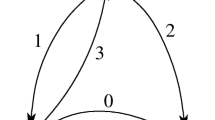Abstract
Max-plus algebra is defined as the set of all real numbers with two binary operations (maximum and addition). This combination of the operations forms a very applicable tool for the investigation of systems working in discrete steps (discrete event dynamic systems). The search for the steady states in such systems leads to the study of the eigenvectors of the production matrix in the corresponding max-plus algebra. A vector x is said to be an eigenvector of a square matrix A if A ⊗ x = λ ⊗ x for some \(\lambda \in {\mathbb {R}}\). In real systems, the input values are usually taken to be in some interval. This paper investigates the properties of eigenspaces for vectors with interval (inexact) coefficients. We suppose that an interval vector X can be split into two subsets according to a forall–exists quantification of its interval entries, i.e., X = X∀⊕X∃. If for any vector of X∀ there is at least one vector of X∃ such that their vector maximum is an eigenvector of A, then X is said to be a λ AE-eigenvector. Analogously, if there is at least one vector of X∃ such that for any vector of X∀ their vector maximum is an eigenvector of A, then X is said to be a λ EA-eigenvector. The properties of such eigenvectors are studied and their characterizations by equivalent conditions are presented. Polynomial and pseudopolynomial algorithms for checking some types of λ EA/λ AE-eigenvectors are suggested.
Similar content being viewed by others
References
Allamigeon X, Legay A, Fahrenberg U, Katz R, Gaubert S (2014) Tropical Fourier–Motzkin elimination, with an application to real-time verification. Internat J Algebra and Comput 24(5):569–607
Butkovič P (2010) Max-linear systems: Theory and Algorithms. Springer, London
Cechlárová K (2001) Solutions of Interval Linear Systems in (max, +)-algebra. In: Proceedings of the 6th international symposium on operational research preddvor, Slovenia, pp 321–326
Collins P, Niqui M, Revol N (2011) A validated real function calculus. Math Comp Sci 5:437–467
Cuninghame-Green RA (1979) Minimax algebra lecture notes in economics and mathematical systems, vol 166. Springer, Berlin
Fiedler M, Nedoma J, Ramík J, Rohn J, Zimmermann K (2006) Linear optimization problems with inexact data. Springer, Berlin
Gavalec M, Plavka J, Ponce D (2016) Tolerance types of interval eigenvectors in max-plus algebra. Inform Sci 367-368:14–27
Gavalec M, Plavka J, Ponce D (2020) EA/AE-eigenvectors of interval max-min matrices. Mathematics. 8(6)
Gavalec M, Plavka J, Tomášková H (2014) Interval eigenproblem in max–min algebra. Linear Algebra Appl 440:24–33
Gavalec M, Plavka J (2003) Strong regularity of matrices in general max–min algebra. Linear Algebra Appl 371:241–254
Litvinov GL, Sobolevskii AN (2001) Idempotent interval ana-lysis and optimization problems. Reliab Comput 7:353–377
Myšková H (2012) On an algorithm for testing t4 solvability of max-plus interval systems. Kybernetika 48(5):924–938
Myšková H (2012) An iterative algorithm for testing solvability of max-min interval systems. Kybernetika 48(5):879–889
Myšková H, Plavka J (2013) X-robustness of interval circulant matrices in fuzzy algebra. Linear Algebra Appl 438:2757–2769
Myšková H, Plavka J (2014) The robustness of interval matrices in max-plus algebra. Linear Algebra Appl 445:85–102
Plavka J (2014) The weak robustness of interval matrices in max-plus algebra. Discrete Appl Math 173:92–101
Plavka J (2005) L-parametric Eigenproblem in max-algebra. Discret Appl Math 150:16–28
Plavka J, Sergeev S (2016) Characterizing matrices with X-simple image eigenspace in max-min semiring. Kybernetika 52:497–513
Plavka J, Sergeev S (2016) X-simple image eigencones of tropical matrices. Linear Algebra and Its Applications 507:169–190
Plavka J, Sergeev S (2018) Reachability of eigenspaces for interval circulant matrices in max-algebra. Linear Algebra and Its Applications 550:59–86
Acknowledgements
The authors are grateful to the referees for their evaluation of the manuscript and for their suggestions and helping comments.
The support of the APVV grant #180373 is gratefully acknowledged.
Author information
Authors and Affiliations
Corresponding author
Ethics declarations
Conflict of Interests
The authors declare that they have no conflict of interest.
Additional information
Publisher’s note
Springer Nature remains neutral with regard to jurisdictional claims in published maps and institutional affiliations.
Rights and permissions
About this article
Cite this article
Myšková, H., Plavka, J. Max-plus steady states in discrete event dynamic systems with inexact data. Discrete Event Dyn Syst 32, 521–538 (2022). https://doi.org/10.1007/s10626-022-00359-3
Received:
Accepted:
Published:
Issue Date:
DOI: https://doi.org/10.1007/s10626-022-00359-3




